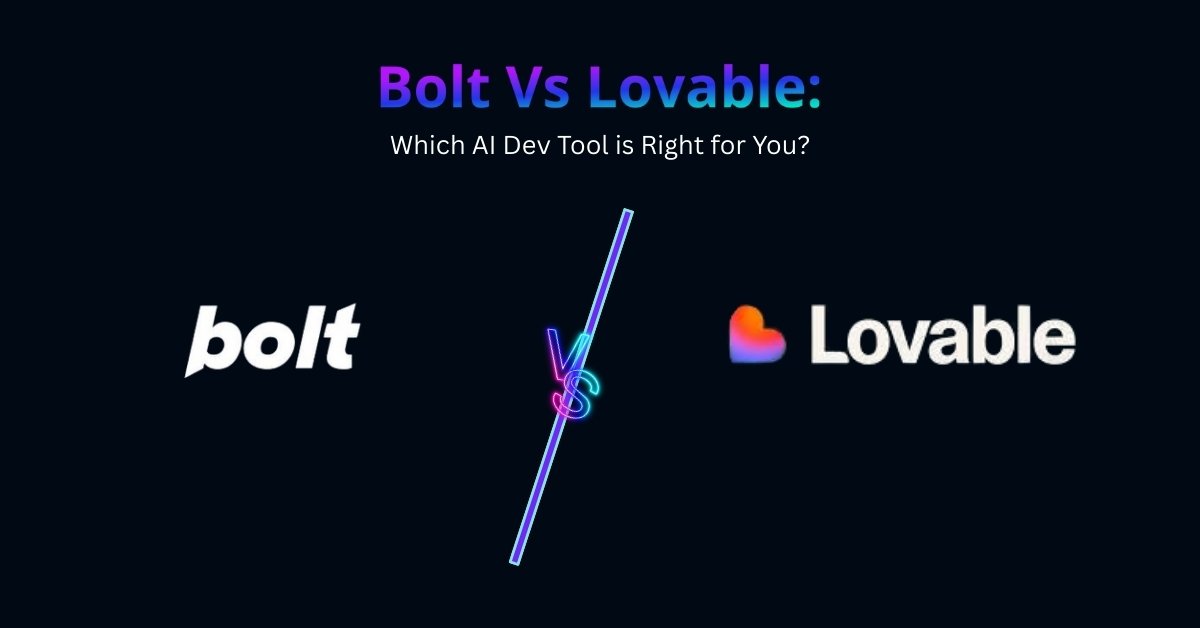Bolt vs Lovable: Know Which AI App Builder is Best for You

The AI app-building world in 2025 revolves around two frontrunners which are Bolt and Lovable. Both promise lightning-fast results, powerful features, and AI-driven creativity. But beneath the surface, these tools take very different paths.
So, which one fits your workflow, goals, and skill level?
This article breaks it down clearly, simply, and without the fluff.
We tested both tools side by side using real-world prompts. From building layouts to setting up logic, we explored how each platform performs in practical scenarios. You’ll see what works, what falls short, and where each tool shines.
We’ll compare how fast they generate apps, how easy they are to use, the quality of their output, what they cost, and how deeply you can customize what they build.
Whether you’re a solo founder, designer, or full-stack dev, this guide will help you make the right pick.
Let’s dive in with real insights, not just promises.
What Is Bolt.new AI?
Bolt.new is an AI-powered app builder that turns plain-text prompts into real, functional web applications. Unlike basic no-code tools, it doesn’t just give you a visual mockup. It gives you production-ready code, ready to edit and deploy.
The standout feature is its built-in development environment. Bolt includes a full browser-based IDE, live preview window, and even a working terminal. You can write logic, install npm packages, connect APIs, and see changes happen instantly.
When you describe an app idea, Bolt responds with clean React and Tailwind code. You can modify the layout, tweak styles, or expand features without starting over. Its “diff-based” update system only changes what’s needed, so iterations stay fast and stable.
Bolt is built for speed, but it doesn’t sacrifice control. It’s ideal for developers who want to move quickly without giving up the power of code. While beginners can still use prompts to get started, the real strength lies in its developer-focused workflow.
Best for: developers, solo builders, and technical founders who want to build fast while keeping full control over the code
What Is Lovable AI?
Lovable.dev is an AI-powered tool that turns plain ideas into functional app prototypes. You describe what you want, and it builds the layout, features, and basic logic automatically.
It uses AI agents like a Product Manager, Designer, and Developer to guide you through each step. These bots help you plan, refine, and build like you’re working with a real team.
Best for: founders, solo creators, and product managers who want to build fast without writing code
Bolt VS Lovable: Key Factors Comparison
Choosing between Bolt and Lovable depends on more than just first impressions. Both platforms promise speed and simplicity, but they approach app building in very different ways. To help you decide, we compared them across key factors like design, development, speed, backend support, pricing, and production readiness.
UI and Design Output
Bolt: Generates clean and professional layouts using React and Tailwind. It responds well to style prompts, producing consistent designs that are ready for production. Drag-and-drop controls exist but feel limited compared to advanced design tools.
Lovable: Focuses on creativity and presentation, making it easy to design modern UIs quickly. Its Designer agent helps non-coders shape layouts with little effort. However, drag behaviors can be buggy and require extra adjustments.
Development Experience (Coding and Editing)
Bolt: Offers a full development environment right in the browser, including IDE, terminal, and npm support. You can sync projects with GitHub and adjust code directly. This makes it perfect for developers who want to keep full control of their projects.
Lovable: Avoids technical details and simplifies the experience by handling most of the coding in the background. Users describe features in plain English, and the platform handles the rest. It works well for idea testing but lacks code export, limiting flexibility for scaling.
Speed and Iteration Flow
Bolt: Uses a diff-based update system, which means it only changes the parts of code you modify. This saves time and prevents errors from overwriting the entire project. It makes iteration fast and smooth for developers who want quick testing.
Lovable: Takes a slower, planning-first approach by working with AI agents to refine requirements before building. This process reduces the chance of mistakes but can feel slower if you just want quick results. It suits users who prefer clarity over speed.
Backend, Database, and Authentication
Bolt: Connects directly with Supabase, making it easier to set up databases and authentication. You can add APIs and build simple backend logic. More complex backend setups are possible, but they require manual coding.
Lovable: Provides light backend support with some ability to connect to data. It handles basic database tasks for prototypes but struggles with advanced needs. Authentication options are minimal, making it less reliable for production-level apps.
Error Handling and Debugging
Bolt: Has a built-in AI assistant that highlights issues in the code and suggests fixes. Developers can use the IDE to identify and correct errors quickly. Its reliability is higher because of the code-first environment.
Lovable: Uses the Developer agent to troubleshoot issues in a conversational way. Sometimes it can resolve problems effectively, but results vary. Users may need multiple retries before the fix works properly.
Pricing and Usage Limits
Bolt: Operates on a token-based system with a large free tier for testing. Paid plans are flexible and good for active developers. The downside is that heavy usage burns through tokens quickly, so costs can rise unexpectedly.
Lovable: Uses a credit-based model that resets daily. It feels simple and predictable, especially for light users. For bigger projects, the limits can slow down progress and push users toward paid plans sooner.
Prototyping vs Production Readiness
Bolt: Creates production-ready apps with clean code that can scale into MVPs. Developers can take projects directly into deployment without rebuilding from scratch. It is a better fit for serious projects that may grow over time.
Lovable: Excels at brainstorming and prototyping with fast, interactive flows. It helps test ideas visually and functionally but lacks the depth for long-term production use. Best suited for proof-of-concept projects.
Community and Learning Curve
Bolt: Appeals strongly to developers familiar with React or Tailwind. Its developer-focused design creates a steep learning curve for non-technical users. Once mastered, it offers unmatched flexibility and power.
Lovable: Designed for simplicity, using plain-English instructions and AI agents that guide you through the process. This makes it easy for beginners and product managers with no coding background to build apps quickly.
Deployment Options
Bolt: Allows you to export full code, sync with GitHub, and host apps anywhere you prefer. This level of freedom makes it practical for real-world production. Developers can deploy quickly and keep ownership of their code.
Lovable: Provides built-in hosting for quick demos and internal testing. However, it doesn’t currently support external code export. This makes it less flexible for scaling apps outside the platform.
Extra Points for SEO and Ranking
Bolt: Strong technical depth, faster iterations, and advanced integration options make it appealing for developers who want more control. It is designed to handle MVPs that need both front-end and backend flexibility.
Lovable: Beginner-friendly, highly collaborative, and efficient for early-stage brainstorming. It’s ideal for turning vague ideas into usable prototypes without requiring technical skills.
Best 3 Bolt and Lovable Alternatives
If Bolt and Lovable don’t quite fit your workflow, No problem we have list of best Bolt new alternatives and Lovable alternatives that offer AI-driven app building with unique strengths. Here are three of the best alternatives worth exploring.
1. Vitara.ai
Vitara positions itself as a next-generation AI app builder that blends speed with simplicity. You describe your idea in plain words, and Vitara delivers a working prototype with both design and functionality in place. Unlike many tools, it emphasizes collaboration, making it easier for teams to brainstorm, refine, and ship ideas faster. Vitara is built to help founders and small teams launch apps without getting stuck in code, while still offering a structured product flow.
Best for: early-stage founders and teams who want a collaborative AI partner to take ideas from concept to prototype quickly.
Also Read:
Vitara vs Lovable: Detailed Comparison
2. Replit
Replit is a powerful cloud-based development environment that lets you code, test, and deploy apps directly in the browser. Its AI assistant, Ghostwriter, helps you generate, debug, and refine code across multiple languages. With built-in hosting, package management, and collaboration features, Replit is a strong choice for technical users who want flexibility without setup headaches.
Best for: developers and students who want to build real apps with AI support while keeping complete control over their code.
3. Windsurf
Windsurf takes a unique approach by combining vibe coding with a streamlined developer experience. It focuses on making collaboration smoother by helping teams generate, edit, and refine large projects together. The platform balances AI automation with manual editing, which makes it easier to scale apps beyond prototypes.
Best for: technical teams and developers working on larger projects who need both AI-powered speed and long-term scalability.
Final Thoughts
Bolt and Lovable both bring unique strengths to AI-powered app building. Bolt shines with real code, developer-focused tools, and production-ready results. Lovable makes prototyping fast and accessible with its collaborative AI agents and design-first approach.
The right choice depends on your goals. If you want speed with code ownership, Bolt is the clear fit. If your priority is brainstorming and testing ideas without technical barriers, Lovable is the easier path. Both are evolving quickly, so the best move is to try each and see which aligns with your workflow.
FAQs Regarding Bolt VS Lovable
What are the main differences between Bolt and Lovable?
Bolt focuses on speed and code ownership, with features like diff-based updates and a full IDE. Lovable emphasizes collaboration and simplicity, using AI agents to guide product design without exposing raw code.
Is Bolt better for developers while Lovable is better for beginners?
Yes, that’s a fair way to see it. Bolt feels like a developer’s playground with full code access, while Lovable removes complexity by focusing on plain-English prompts and collaborative AI agents. If you’re technical, Bolt gives you more control. If you’re new to building, Lovable is easier to start with.
Can I launch a real business app using these tools?
You can, but with limits. Bolt produces production-ready code you can deploy and scale, which makes it suitable for MVPs or early-stage apps. Lovable is stronger for prototyping and validating ideas, but less flexible for long-term scaling. For serious business use, many teams combine these tools with manual development.
How do Bolt and Lovable handle design customization?
Bolt lets you fine-tune styles in React and Tailwind, giving developers complete design freedom. Lovable offers polished design out of the box but doesn’t let you edit raw code. This makes Bolt better for unique branding, while Lovable is better for quick, professional-looking interfaces.
Are these tools cost-effective for startups?
Yes, both are budget-friendly compared to hiring developers from day one. Bolt’s token system gives more freedom for active builders, while Lovable’s credit model is predictable for light users. Startups can test ideas cheaply before committing to bigger development costs.
Will these AI tools replace the need for developers?
Not yet. They’re powerful for speed and prototyping, but they don’t fully replace human developers. Complex apps, custom integrations, and advanced scaling still need manual coding. Think of Bolt and Lovable as accelerators, not replacements.


